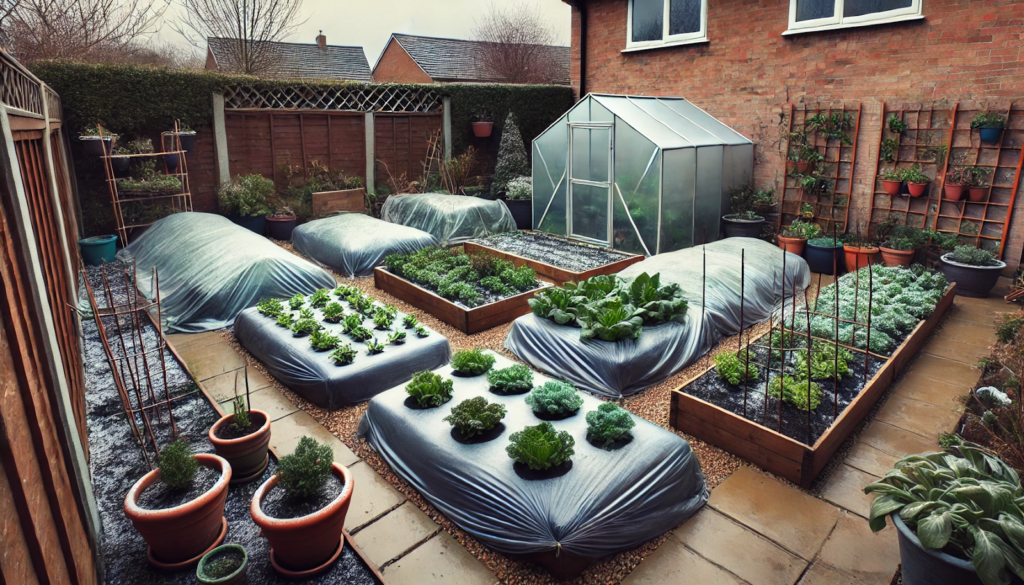When temperatures drop, your garden becomes vulnerable to frost, wind, and freezing conditions that can damage or kill plants. But with the right techniques, you can protect your garden from cold weather and help your plants survive—and even thrive—through winter or unexpected cold snaps.
In this guide, you’ll learn the most effective ways to shield your garden from the cold, preserve your hard work, and set your plants up for success in the following season.
Why Cold Protection Matters
Even a single frost can:
- Kill sensitive plants
- Damage fruit and vegetable harvests
- Halt plant growth and weaken roots
- Cause long-term stress that affects future productivity
Whether you live in a cold climate or experience occasional drops in temperature, preparing in advance can make a big difference.
1. Know Your Frost Dates and Zones
Before preparing for the cold, it’s important to understand your local growing conditions.
- Find your USDA Hardiness Zone (or local equivalent)
- Know your average first and last frost dates
- Watch weather forecasts regularly during fall and winter
Tip: Many cold-weather problems can be avoided by planting frost-tolerant varieties and timing your plantings according to local data.
2. Use Mulch for Insulation
Mulch acts as a natural insulator, keeping soil temperatures stable and protecting plant roots.
Best mulch types for winter:
- Straw or hay (seed-free)
- Shredded leaves
- Wood chips
- Pine needles
Apply a 2 to 4-inch layer around the base of plants, but avoid piling it directly against stems or trunks.
3. Cover Plants with Frost Cloths or Blankets
Physical covers can trap heat and protect plants from overnight freezes.
Materials to Use:
- Frost cloth (also called row cover)
- Old bed sheets or blankets
- Burlap
- Garden fabric
How to Cover:
- Drape loosely over the plant to allow air circulation
- Anchor the edges with bricks, rocks, or stakes
- Remove during the day if temperatures rise
Tip: Avoid using plastic directly on plants—it can trap moisture and cause damage.
4. Use Cold Frames and Cloches
Cold frames and cloches create mini-greenhouses for plants, ideal for overwintering or extending the growing season.
Cold Frame:
- A bottomless box with a clear top (often hinged)
- Great for lettuces, spinach, herbs, and seedlings
Cloches:
- Bell-shaped covers made of glass or plastic
- Ideal for protecting individual plants
DIY Idea: Use large plastic bottles with the bottoms cut off as mini cloches.
5. Move Containers Closer to Shelter
Potted plants are more vulnerable to cold than those in the ground.
How to Protect:
- Move containers near a warm wall, inside a shed, or into a greenhouse
- Group pots together for added warmth
- Wrap pots in bubble wrap or burlap to insulate the roots
Choose frost-hardy containers like ceramic, thick plastic, or fabric grow bags.
6. Water Before a Freeze
Moist soil retains heat better than dry soil, offering extra protection during a freeze.
Best Practices:
- Water early in the day before the temperature drops
- Avoid overwatering—soggy soil can cause root rot
- Focus on recently planted or shallow-rooted crops
7. Prune Strategically
Winter is a great time to prune trees and shrubs—but timing matters.
What to Know:
- Do not prune tender perennials before a freeze (wait until spring)
- Remove damaged or diseased branches anytime
- Prune deciduous trees and shrubs while they are fully dormant
Avoid heavy pruning just before a cold snap, as it can stimulate new growth that is vulnerable to frost.
8. Use Windbreaks to Reduce Exposure
Wind can dry out and damage cold-stressed plants.
Wind Protection Ideas:
- Erect temporary barriers using burlap, fences, or straw bales
- Plant evergreen hedges or dense shrubs as long-term solutions
- Use garden structures like trellises or walls for shelter
Position windbreaks on the north or northwest side of the garden where cold winds tend to originate.
9. Bring Tender Plants Indoors
For tropical or frost-sensitive plants, the best option is to bring them inside.
Indoor Care Tips:
- Choose a bright window with good airflow
- Reduce watering frequency in winter
- Watch for pests like spider mites or aphids
- Gradually reintroduce to outdoor conditions in spring
Ideal for houseplants, potted herbs, and tropical flowers like hibiscus or mandevilla.
10. Extend the Growing Season with Tunnels or Row Covers
Low tunnels and floating row covers are great for protecting larger garden areas.
How to Set Up:
- Use wire hoops to support lightweight fabric
- Cover beds and secure edges with soil or bricks
- Remove during sunny days to prevent overheating
This method is especially helpful for leafy greens, root vegetables, and herbs.
Bonus: Use Heat Sources for Greenhouses
If you’re gardening in a greenhouse, you may want to supplement heat during cold spells.
Options Include:
- Heated mats under seed trays
- Small electric or propane greenhouse heaters
- Compost piles or thermal barrels for passive heat
Always monitor temperatures and humidity to avoid overheating or mold.
Prepare Now, Grow Later
Cold weather doesn’t have to spell disaster for your garden. With thoughtful planning, simple tools, and timely action, you can protect your plants from frost and freeze, extend your harvest, and build a stronger, more resilient garden year after year.






